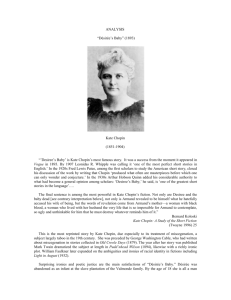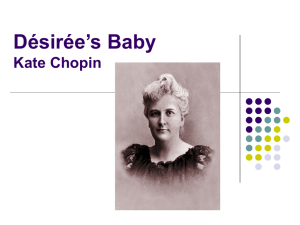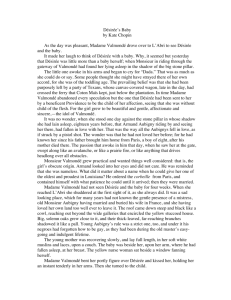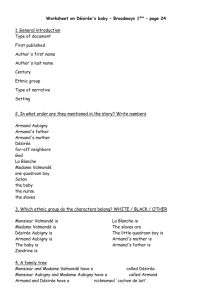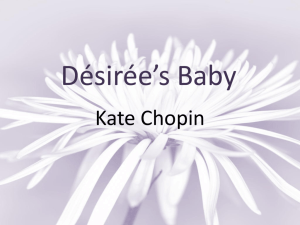Kate Chopin's "Désirée's Baby" Slavery and Racial Discrimination Theme
advertisement
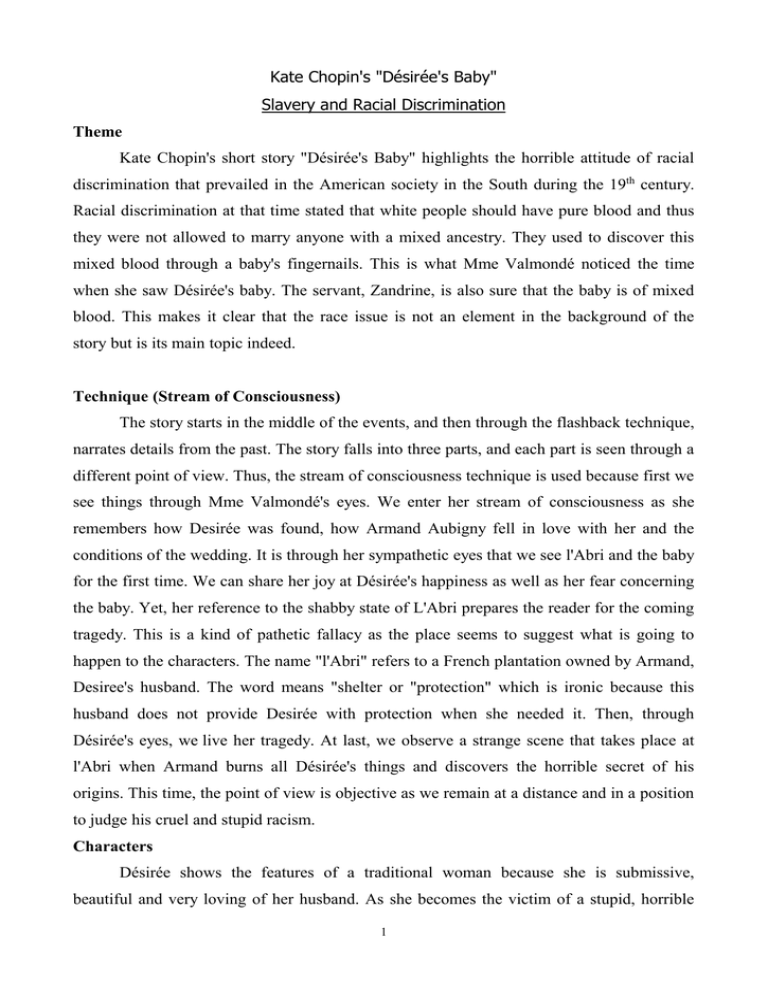
Kate Chopin's "Désirée's Baby" Slavery and Racial Discrimination Theme Kate Chopin's short story "Désirée's Baby" highlights the horrible attitude of racial discrimination that prevailed in the American society in the South during the 19th century. Racial discrimination at that time stated that white people should have pure blood and thus they were not allowed to marry anyone with a mixed ancestry. They used to discover this mixed blood through a baby's fingernails. This is what Mme Valmondé noticed the time when she saw Désirée's baby. The servant, Zandrine, is also sure that the baby is of mixed blood. This makes it clear that the race issue is not an element in the background of the story but is its main topic indeed. Technique (Stream of Consciousness) The story starts in the middle of the events, and then through the flashback technique, narrates details from the past. The story falls into three parts, and each part is seen through a different point of view. Thus, the stream of consciousness technique is used because first we see things through Mme Valmondé's eyes. We enter her stream of consciousness as she remembers how Desirée was found, how Armand Aubigny fell in love with her and the conditions of the wedding. It is through her sympathetic eyes that we see l'Abri and the baby for the first time. We can share her joy at Désirée's happiness as well as her fear concerning the baby. Yet, her reference to the shabby state of L'Abri prepares the reader for the coming tragedy. This is a kind of pathetic fallacy as the place seems to suggest what is going to happen to the characters. The name "l'Abri" refers to a French plantation owned by Armand, Desiree's husband. The word means "shelter or "protection" which is ironic because this husband does not provide Desirée with protection when she needed it. Then, through Désirée's eyes, we live her tragedy. At last, we observe a strange scene that takes place at l'Abri when Armand burns all Désirée's things and discovers the horrible secret of his origins. This time, the point of view is objective as we remain at a distance and in a position to judge his cruel and stupid racism. Characters Désirée shows the features of a traditional woman because she is submissive, beautiful and very loving of her husband. As she becomes the victim of a stupid, horrible 1 racism we can thus share her anxiety, her fear and her pain. Désirée tries to convince her husband that she has brown hair and grey eyes and thus cannot have mixed blood, he is not ready to listen and he banishes her from his life, which later leads her to commit suicide. The husband Armand is an example of racial discrimination who completely changes as the events proceed. After his love for and marriage to Désirée, we see him as an angel. We see him first through Mme Valmondé's eyes at the beginning of the story as a passionate man who has fallen in love "as if struck by a pistol shot", but is very cruel towards his Negroes. There is something mysterious about his childhood. He has lived in Paris for the first eight years of his life, his mother having refused to come and live in America. It is only after her death that he and his kind father came back to Louisiana. Marriage and happiness have changed him completely, and Désirée says that he has not punished any of his black servants since the birth of his child. Yet, when it becomes clear that his baby has black origins, his attitude changes. "The old love light" disappears from his eyes, and is replaced with "the very spirit of Satan" in his dealings with the slaves." In fact his cruelty has all come back to the surface and of course since Désirée's origins are unknown, he deduces from the fact that the baby is not white, that Désirée is not white. This is for him enough reason to reject her, to deny all the love he had felt for her. He feels hurt because his honour has been stained; he feels cheated even though Monsieur Valmondé warned him before the wedding. He should have known there was a risk of such a surprise in marrying Désirée. However, just as his passion had blinded him then, it blinds him again in his hate for "the race cursed with the brand of slavery." We can be quite sure he has not felt any regret after the young woman's death. We can see him at the end of the story burning all her priceless possessions as if he wanted to purify himself from his momentary association with a woman who was not white. We can then only imagine his pain and suffering at the discovery of the truth. We can suppose that this hate which has driven Désirée to suicide will turn against himself. 2
